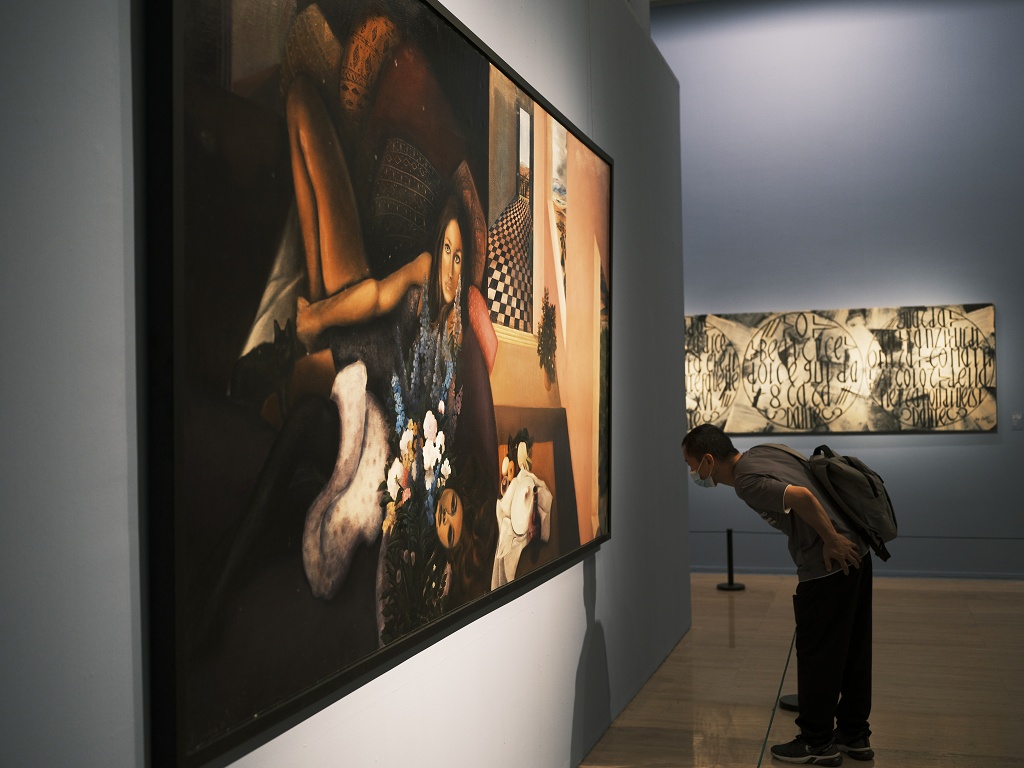Prosperity in Diversity

Scorching summer days with bucket-list-worthy experiences are few and far between, and the National Art Museum of China (NAMOC) has air conditioning alongside nearly 4,000 pieces from over 100 countries on five continents.
Recently, the museum organized “Prosperity in Diversity: Collection of International Artworks from NAMOC (II)” in Beijing as part of an exhibition series celebrating its 60th anniversary. Over 70 pieces (sets) of international art treasures are on display including oil paintings, prints, sculptures, photographs and more.
Road to Modernism
NAMOC’s rich international art collection showcases the evolution of international art since the 20th century. The section “Road to Modernism” features more than 30 works mainly donated by German collector Peter Ludwig and his wife, the French Academy of Fine Arts, and the artists themselves.
In 1996, Peter Ludwig and his wife selected 89 pieces (sets) of art from their collection including those by 82 European and American modern artists and donated them to NAMOC. Portrait of Peter Ludwig (1980) by American artist Warhol Andy captured Ludwig in a three-quarters view, looking at the artist in a serious and attentive manner. Different colored lines, featuring a fast sketch, repeat and emphasize the contours of the face, hand, and shoulder. The connection between the figurative depiction and brightly structured surface creates an impressive contrast.

Portrait of Peter Ludwig, 1980. (Photo by Qin Bin/China Pictorial)
Among Ludwig’s exhibited donations, Sky 2 (1967), a three-dimensional screen-print collage by British artist Joe Tilson, is eye-catching and features many beautiful flying “elves.” Randomly pasted on a blue background with white dots, various birds, plants and flying objects, rich in color, simple in shape, and strong in planarity, seem to sing and dance in the blue sky among white floating clouds. But most of them are head down, as if “flying” from the envelope pinched by a hand with only its thumb and index finger exposed.

Sky 2, 1967. (Photo courtesy of the National Art Museum of China)
From Leo Tolstoy, Karl Marx, and Albert Einstein to Mei Lanfang, Guo Moruo, and Qian Xuesen... The Wise Men of the Century (1999) by Chinese master Feng Yuan presents a “planet” of wise men. These pioneers in various fields occupy four-fifths of the frame, against an arc-shaped horizon, implying an endless queue and the depth of history and civilization.

The Wise Men of the Century, 1999. (Photo by Qin Bin/China Pictorial)
The Silk Road
In 1877, German geographer Ferdinand von Richthofen coined the term “Silk Road,” referring to the ancient communication line connecting Asian, European, and African continents. The term not only refers to the terrestrial route stretching from the ancient capital Chang’an (located near modern Xi’an City, Shaanxi Province) to Rome jointly blazed by Zhang Qian, a Han Dynasty (202 B.C.-220 A.D.) envoy, and the people in the places he visited along the way, but also the maritime route from Quanzhou Port in China’s Fujian Province to countries in the East and the West.
In 2018, NAMOC established the Silk Road International Alliance of Art Museums and Galleries, aiming to expand the dimensions of international cultural exchange through cooperation.
The section “Significance of the Silk Road” focuses on more than 30 works by artists from countries along the Belt and Road. It reflects on inheritance and promotion of their own national culture and acceptance and respect for others’ cultures and interprets the spirit of the Silk Road, namely “peace and cooperation, openness and inclusiveness, and mutual learning and mutual benefit,” with rich visual artistic language.
Iranian artist Farahnaz Azarabadihagh portrayed a dream road connecting the East and the West in her work Road of Dreams (2016) with acrylic and batik applied to canvas. Two huge windows are open to a new realm featuring layers of colors, which transform reality into poetic expressions. The Belt and Road Initiative, first coined in 2013, invites people to achieve common prosperity through commercial and cultural exchange, on an equal premise of mutual benefits, mutual respect and development in harmony with nature, echoing the artist’s view that “this new global concept will lead everyone toward a new path.”

Lontano da Xian (2016) by Italian artist Omar Galliani promotes the spirit of the Silk Road in a panel of large dimensions, produced in pencil. A mirrored androgynous figure whose neck has a tattoo of a pomegranate, an Eastern fruit that arrived in the Mediterranean on the convoy of silk traders thousands of years ago. It is worthy noting that the two backs of the head form the shape of a vase that contains a constellation.

The Chinese and Arabs were the first to develop the paper industry globally. Khalid Hamza, an artist from Sudan, demystified the art of Arabic calligraphy featuring many varieties and aesthetics and showcased them in the piece Forest of Words (2017) with acrylic applied to his canvas as an interpretation of various natural landscapes. Shapes in his work imitate trees and branches, creating an unprecedented color and aesthetic value through interlacing, reflecting the artist’s emotion and the infinite beauty of the universe.

As a saying goes, “delicious soup is made by combining different ingredients.” A concrete carrier of culture, art forms the mind schema of a country and works with pieces from around the world to establish an artistic palace for humanity.